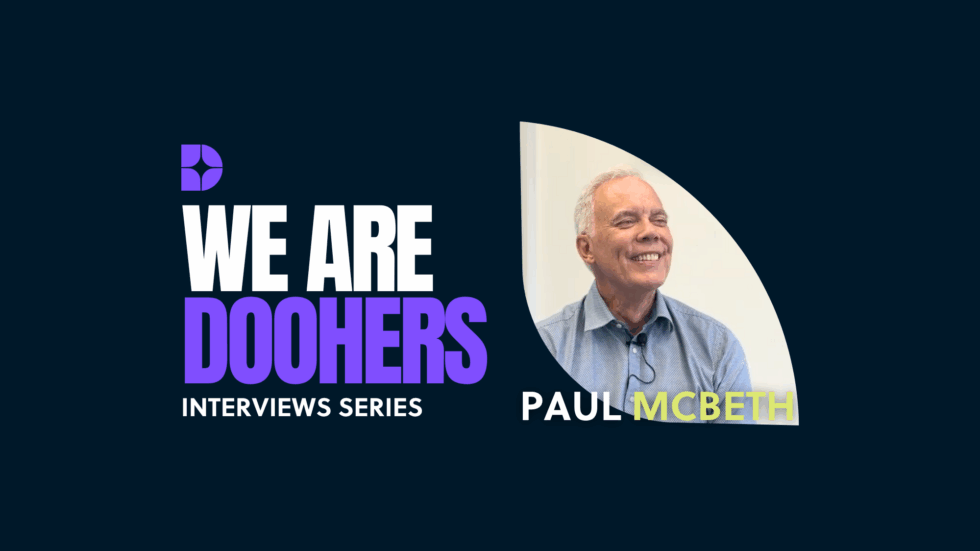As part of our #WeAreDOOHers series, we spoke with Paul McBeth, Global Marketing Director at Executive Channel Network (ECN), the leading Digital Out-of-Home media media owner in offices across Europe. Paul shares his expert perspective on how programmatic DOOH is evolving into a full-funnel, context-rich channel for performance and brand-building alike.
Watch the full interview:
From amplifying brand stories to reshaping office media
With a career built on growing media brands, Paul McBeth’s mission at ECN is clear: elevate the value of office-based DOOH environments across Europe through storytelling, strategic partnerships, and measurable campaign effectiveness, backed by data that proves audience reach, engagement, and business impact.
And the numbers speak for themselves. A recent ECN study revealed that London office professionals spend more than £15.4 billion annually in mobile commerce while physically present in their workplaces, making office-based DOOH a prime touchpoint for influence and action.
From static screens to strategic outcomes
Asked about the biggest shift he’s witnessed in DOOH over the past few years, Paul points to the growing convergence between online, offline, and mobile environments.
For Paul, the rise of m-commerce, where consumers carry a virtual store in their pockets through their smartphones, has significantly expanded the role of DOOH. This development makes DOOH a crucial channel that bridges the online and offline environments, enabling brands to connect with consumers effectively throughout the entire path to purchase.
In this context, Paul sees programmatic DOOH not just as a niche execution tactic but as a bridge between brand building and performance, with growing importance in omnichannel campaigns.
Challenging outdated perceptions
Despite its growing maturity, Paul McBeth notes that misconceptions around programmatic DOOH still linger particularly around pricing and funnel positioning.
For Paul, this means that while programmatic DOOH may come at a premium but the quality of the environment and the heightened audience engagement make it a worthwhile investment for brands seeking meaningful impact.
Another common misunderstanding? That programmatic DOOH is only suitable for bottom-funnel activation.
His solution: ongoing industry education to bring clarity and confidence to marketers.
The golden rules of a successful DOOH campaign
So how can advertisers set themselves up for success in this evolving landscape? Paul McBeth lays out a few guiding principles:
- Clarity of KPIs: Success starts with knowing exactly what you want to achieve. Whether the goal is brand awareness, consideration, or direct response, setting clear and measurable objectives is essential to guide strategy and evaluate performance.
- Contextual awareness: Understanding where and how your message will be seen is crucial. This includes the physical environment, the audience’s mindset, the time of day, and even external triggers like weather. Context strengthens relevance and increases the likelihood of engagement.
- Creative optimisation: Leveraging motion in creative assets is a powerful way to capture attention. Full-motion video, in particular, has proven to lift campaign performance.
- Omnichannel alignment: As investment in online video continues to grow, it’s important for advertisers to consider how DOOH fits into the broader media mix. Integrating DOOH with other digital channels, especially video, ensures consistency, improves frequency, and enhances the overall effectiveness of a campaign.
For Paul, context isn’t just a detail, it’s a differentiator. Whether it’s tapping into commuter patterns, reacting to external triggers, or aligning with business cycles, the success of programmatic DOOH is deeply anchored in relevance.
Looking ahead: the next frontier for programmatic DOOH
Paul sees the next three to five years as a time of major transformation for programmatic DOOH, and one filled with opportunity. AI, in particular, stands out. Not only will it accelerate the planning and buying process, but it will also unlock the ability to generate hundreds, even thousands, of creative variations tailored to different contexts and triggers.
Format innovation is another key trend on Paul’s radar. He sees growing potential in how physical environments can be reimagined as dynamic media surfaces. For DOOH, this means richer storytelling and more immersive brand experiences.
Smart Cities will also reshape the role of screens in public and professional spaces:
This aligns directly with ECN’s approach:
For Paul, these shifts point to a broader evolution. Programmatic DOOH is no longer just about media delivery, it’s becoming a multi-dimensional tool for communication, creativity, and utility.
As the lines between media, technology, and environment continue to blur, DOOH is well-positioned to thrive at the heart of this new landscape. And with leaders like Paul at the helm, one thing is clear: the evolution of DOOH is far from over and context will be the compass guiding the way.
